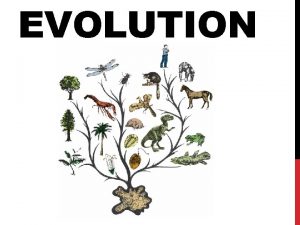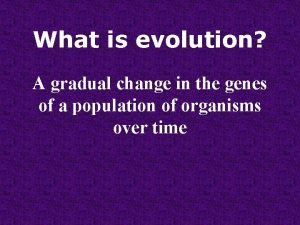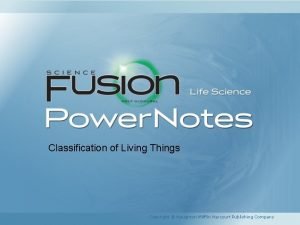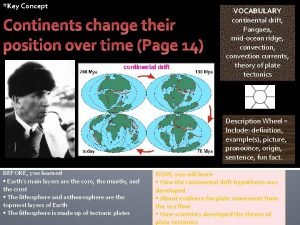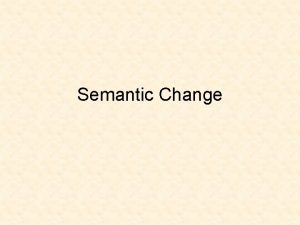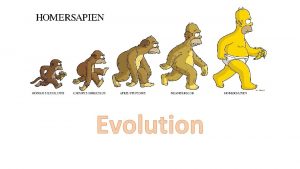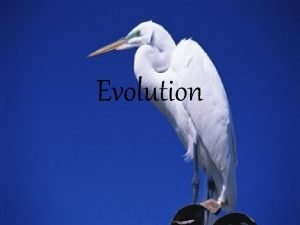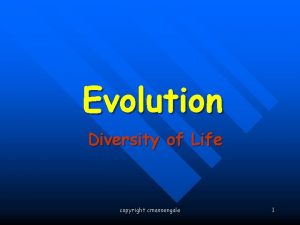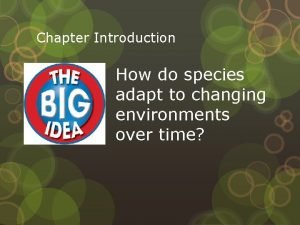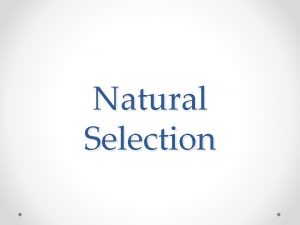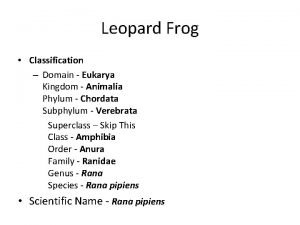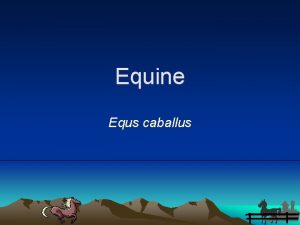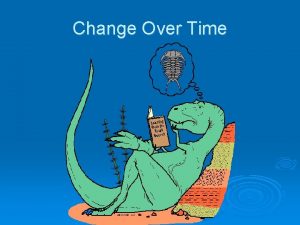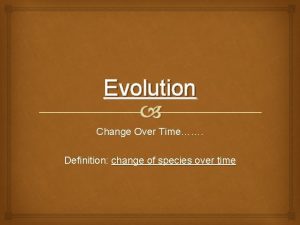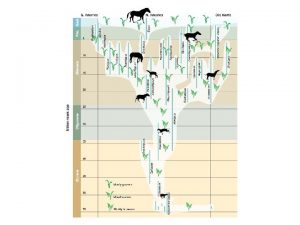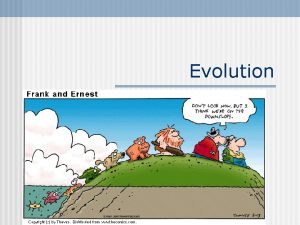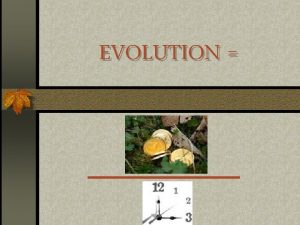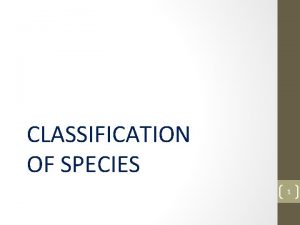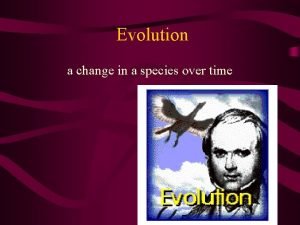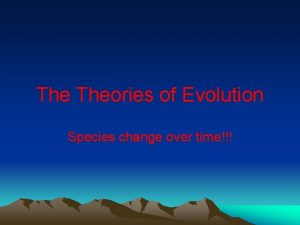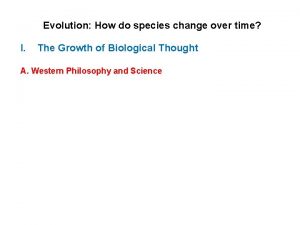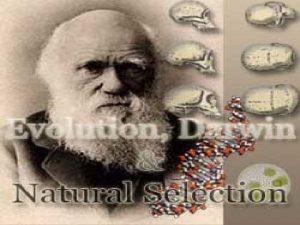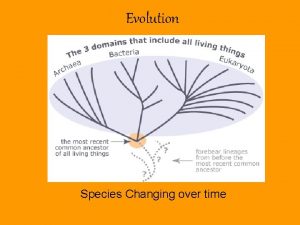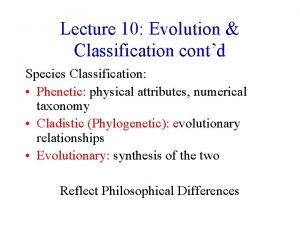EVOLUTION CLASSIFICATION Evolution change in species over time























- Slides: 23

EVOLUTION & CLASSIFICATION

Evolution: change in species over time Species ADAPT (or change) in order to increase chance of survival Variation among species can occur due to… Recombination of traits (mating) Mutations in DNA sequence

Evidence for Evolution. Fossils Compare them to each other or current organisms (Chimp) (Peking Man) (Human)

Evidence for Evolution: Anatomical Structures Homologous: similar structures in various organisms EX. Similar arm and hand bones in human, bat, bird, whale

Evidence for Evolution: Anatomical Structures Vestigal: reduced in size and function EX. Pelvic bones in whale; appendix in humans

Evidence for Evolution: Anatomical Structures Analogous: similar structure, not same ancestor EX. Wings of bird vs. wings of butterfly

Evidence of Evolution. Embryology: similarities in fetal development Mouse Embryo Human Embryo

Evidence for Evolution. Biochemistry / DNA: similarities in the chemical compounds that make up organisms / similar DNA patterns Ex. 80% similar to Insects Ex. 99% similar to Chimps

THEORY of EVOLUTION Charles Darwin Naturalist who studied the diversity of organisms Developed the concept of NATURAL SELECTION Born Feb. 12 th, 1809 in England

Charles Darwin 1831 -1836 Darwin served as a naturalist on the HMS Beagle He studied plants, animals, and fossils from various locations in and around South America Developed several theories- one of which was the Theory of Natural Selection (aka “Survival of the Fittest”)

Darwin & the Galapagos Islands

THEORY OF NATURAL SELECTION: Variation within populations- natural differences among same species Some variations are favorable- improve ability to function and reproduce Not all young survive- killed by disease, predators; only some reproduce Survivors are those with favorable traitsoffspring inherit those traits/genes

Natural Selection - Galapagos

Types of Evolution: Divergent Evolution- isolated species evolved independently Ex. Polar Bear / Brown Bear

Types of Evolution: Convergent Evolution- similar adaptations in response to similar environment Ex. Big ears on desert creatures

Types of Evolution: Co-Evolution- adaptations affected by interaction with other organisms Ex. Pollinators and flowers

CLASSIFICATION: Grouping of things according to similar characteristics WHY? Show evolutionary relationships (phylogenetic tree) Learn about the similarities/differences of items Discover relationships between living and nonliving things Gives a unique name to each organism, etc.

TAXONOMY: Biological classification system of naming and organizing organisms Binomial Nomenclature – “two-name system of naming” developed by Carolus Linneaus (18 th century Swedish scientist)

All living things are classified into… Kingdom Phylum Class Order Family Genus Species ex. Animalia (Broadest) ex. Chordata ex. Mammalia ex. Primates ex. Hominidae ex. Homo ex. sapiens (Most specific)

How to name an organism… Binomial nomenclature uses the Genus and the species of an organism to name it Genus is capitalized species is NOT capitalized Both are underlined or italicized Ex. Homo sapiens or Homo sapiens

Dichotomous Key: AKA Taxonomic Key- a guide designed to identify organisms; uses pairs of observable traits to pinpoint the identity of an organism

Keys to creating a “KEY”… Use constant characteristics (something it always has) rather than variable ones. Use measurements rather than terms like "large" and "small". Make the choice a positive one - something "is" instead of "is not". If possible, start both choices of a pair with the same word. Precede the descriptive terms with the name of the part to which they apply.

Example- 1. a. wings covered by an exoskeleton …go to step 2 b. wings not covered by an exoskeleton …go to step 3 2. a. body has a round shape ……ladybug b. body has an elongated shape ……grasshopper 3. a. wings point out from the side of the body …dragonfly b. wings point to the posterior of the body …housefly
 The gradual change in a species over time
The gradual change in a species over time The gradual change in a species over time is
The gradual change in a species over time is Why do classification systems change over time?
Why do classification systems change over time? A keystone species is a species of plants and animals
A keystone species is a species of plants and animals Change over time essay
Change over time essay Communities change over time
Communities change over time Continents change position over time
Continents change position over time Semantic shift
Semantic shift Coevolution
Coevolution A gradual change in a community over time.
A gradual change in a community over time. It is a process of change through time
It is a process of change through time Change in hereditary features over time
Change in hereditary features over time Copyright
Copyright Evolution of species 2
Evolution of species 2 The slow gradual change in a species is called
The slow gradual change in a species is called Start time, end time and elapsed time
Start time, end time and elapsed time Over the mountains over the plains
Over the mountains over the plains Siach reciting the word over and over
Siach reciting the word over and over Taking over navigational watch
Taking over navigational watch Systematic position of horse
Systematic position of horse Classification of leopard frog
Classification of leopard frog Phylum horse
Phylum horse Taxonomic classification of rabbit
Taxonomic classification of rabbit Direct changeover and parallel running
Direct changeover and parallel running
